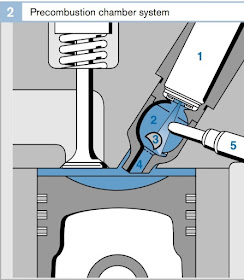The shape of a combustion chamber helps in determining the quality of combustion and therefore the performance and exhaust characteristics of a diesel engine. Appropriate design of combustion chamber combined with piston action produces whirl, squish and turbulence effects that are used to improve the distribution of fuel and air inside the combustion chamber.
The following technologies are used in diesel engines:
- Undivided combustion chamber for Direct Injection (DI) engines
- Divided combustion chamber for Indirect Injection (IDI) engines
Between these two, undivided combustion chamber is predominantly used in vehicles due to their more fuel savings and lesser noise and vibration compared to the divided ones.
Undivided Combustion Chamber (DI):
The direct injection process involves injecting the fuel directly into the combustion chamber. The combustion chamber also relies on the shape of piston crown. Fuel atomization, heating, vaporization and mixing with the air must take place in rapid order.
During the intake and compression strokes, special shape of the intake port in the cylinder head creates an air vortex inside the chamber. Of the combustion chamber designs, the most widely used at present is the w piston crown recess.
The design of a combustion chamber must also ensure even distribution of the fuel inside the chamber so that rapid mixing of air and fuel can take place. A multi-hole nozzle is used in the direct injection process to achieve better atomization of the fuel. The pressure required for direct injection is pretty high at 2200 bar.
In practice, there are two types of direct injection:
- Systems in which mixture formation happens by specifically created air-flow effects
- Systems which control mixture formation virtually by means of fuel injection and largely avoid any kind of air-flow effects
In the latter case, no effort is wasted in creating air turbulence and therefore it helps in more effective cylinder charging and smaller gas replacement losses. However, it demands better nozzle positioning, higher number of nozzle jets and higher intensity of injection pressure in order to provide effective air-fuel mixture.
Direct Combustion Chamber:
As already mentioned, indirect injection engines are far less economical and noisy, along with higher exhaust gas emissions compared to the engines with direct injection technology. As a result, direct combustion chambers are rarely used.
There are two types of processes with direct combustion technology:
- Pre-combustion chamber system
- Whirl chamber system
Pre-Combustion Chamber system:
In the pre-chamber system, fuel is injected into a hot pre chamber recessed into the cylinder head. Pre chambers are much smaller in size compared to the main combustion chamber. The fuel is injected via a pintle nozzle(1) at a relatively lower pressure up to 450 bar. To make sure fuel is impartially burnt, only a small amount of air is supplied to the pre combustion chamber. A specially shaped baffle(3) is positioned at the centre of the pre combustion chamber. The injected fuel strikes the baffle and mixes thoroughly with air.
The partially combusted fuel/air mixture is sent to the main combustion chamber via a connecting channel(4), where it mixes with the available air and burns rapidly. The ratio of pre combustion chamber volume to the main combustion chamber volume is approx. 1:2.
A glow plug(5) is positioned on the lee side of the air flow. A controlled post glow period of up to 1 minute after cold start can help in improving exhaust gas characteristics and reduce engine noise during warm up period.
Swirl Chamber System:
In this process, combustion is initiated in a separate chamber (swirl chamber) that has approx. 60% of the compression volume. The spherical and disc shaped swirl chamber is linked by a connecting channel to the main combustion chamber at a specific angle.
During the compression stroke, air entering via connecting channel is set in a swirling motion. The fuel is then injected so that the air swirl penetrates perpendicular to its axis and meets a hot section of the chamber wall on the opposite side of the chamber.
As soon as combustion starts, the air fuel mixture is delivered under pressure to the main combustion chamber where it mixes with the remaining air. Since the cross section of the connecting channel between swirl chamber and main combustion chamber is larger than the one in the pre-combustion chamber, the gas flow losses are relatively lower in swirl chamber design. This helps in higher internal efficiency and lesser fuel consumption. However, the combustion noise is higher in swirl chamber design.




Informative, Thanks.I would like to suggest SmileBazar, online shopping website offering made in India Products. Buy car accessories at lowest prices. Hope you enjoy discovering new products.
ReplyDelete
ReplyDeleteHi dear,
Thank you for this wonderful post. It is very informative and useful. I would like to share something here too.The best selection of Japanese truck and bus parts Shop Now TRUCK PARTS SYDNEY & BRISBANE Looking for parts to suit your Hino, Isuzu, or Mitsubishi Fuso, then Truckparts Sydney / Brisbane have you covered. We cover the full range of all cab parts from headlamps to bumpers, dash boards&hellip.
hino cab